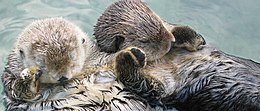Marine biology
| Part of a series on |
| Biology |
|---|
Marine biology is the scientific study of the biology of
A large proportion of all
Marine life is a vast resource, providing food, medicine, and raw materials, in addition to helping to support
Many species are economically important to humans, including both finfish and shellfish. It is also becoming understood that the well-being of marine organisms and other organisms are linked in fundamental ways. The human body of knowledge regarding the relationship between life in the sea and important cycles is rapidly growing, with new discoveries being made nearly every day. These cycles include those of matter (such as the
Biological oceanography
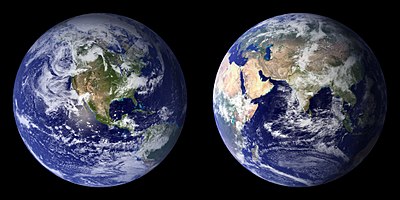
Marine biology can be contrasted with biological oceanography. Marine life is a field of study both in marine biology and in biological oceanography. Biological oceanography is the study of how organisms affect and are affected by the physics, chemistry, and geology of the oceanographic system. Biological oceanography mostly focuses on the microorganisms within the ocean; looking at how they are affected by their environment and how that affects larger marine creatures and their ecosystem.[6] Biological oceanography is similar to marine biology, but it studies ocean life from a different perspective. Biological oceanography takes a bottom up approach in terms of the food web, while marine biology studies the ocean from a top down perspective. Biological oceanography mainly focuses on the ecosystem of the ocean with an emphasis on plankton: their diversity (morphology, nutritional sources, motility, and metabolism); their productivity and how that plays a role in the global carbon cycle; and their distribution (predation and life cycle).[6][7][8] Biological oceanography also investigates the role of microbes in food webs, and how humans impact the ecosystems in the oceans.[6][9]
Marine habitats
| Marine habitats |
|---|
 |
| Coastal habitats |
| Ocean surface |
|
| Open ocean |
| Sea floor |
Marine habitats can be divided into
Intertidal and near shore

Estuaries

Reefs
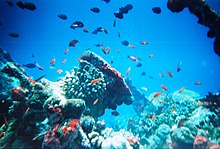
Much attention in marine biology is focused on coral reefs and the
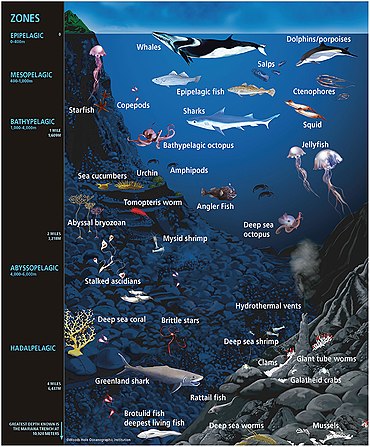
Open ocean
The open ocean is relatively unproductive because of a lack of nutrients, yet because it is so vast, in total it produces the most primary productivity. The open ocean is separated into different zones, and the different zones each have different ecologies.
Deep sea and trenches
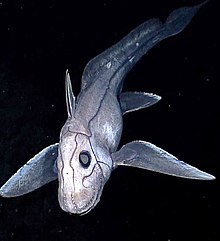
The deepest recorded
Marine life
| Part of a series of overviews on |
| Marine life |
|---|
 |
In biology many phyla, families and genera have some species that live in the sea and others that live on land. Marine biology classifies species based on the environment rather than on taxonomy. For this reason marine biology encompasses not only organisms that live only in a marine environment, but also other organisms whose lives revolve around the sea.
Microscopic life
As inhabitants of the largest environment on Earth, microbial marine systems drive changes in every global system. Microbes are responsible for virtually all the
Microscopic life undersea is incredibly diverse and still poorly understood. For example, the role of viruses in marine ecosystems is barely being explored even in the beginning of the 21st century.[24]
The role of
Plants and algae
Microscopic algae and plants provide important habitats for life, sometimes acting as hiding places for larval forms of larger fish and foraging places for invertebrates.
Algal life is widespread and very diverse under the ocean. Microscopic photosynthetic algae contribute a larger proportion of the world's photosynthetic output than all the terrestrial forests combined. Most of the niche occupied by sub plants on land is actually occupied by macroscopic algae in the ocean, such as Sargassum and kelp, which are commonly known as seaweeds that create kelp forests.
Plants that survive in the sea are often found in shallow waters, such as the
Invertebrates
As on land,
Fungi
Over 10,000
Vertebrates
Fish
A reported
Reptiles
Birds
Birds adapted to living in the
Mammals
There are five main types of marine mammals, namely
; and the polar bear. All are air-breathing, and while some such as the sperm whale can dive for prolonged periods, all must return to the surface to breathe.[34][35]Subfields
The
Through constant monitoring of the ocean, there have been discoveries of marine life which could be used to create remedies for certain diseases such as cancer and leukemia. In addition, Ziconotide, an approved drug used to treat pain, was created from a snail which resides in the ocean.[36]
Related fields
Marine biology is a branch of
Distribution factors
An active research topic in marine biology is to discover and map the
Most ocean life breeds in specific places, nests or not in others, spends time as juveniles in still others, and in maturity in yet others. Scientists know little about where many species spend different parts of their life cycles especially in the infant and juvenile years. For example, it is still largely unknown where juvenile sea turtles and some year-1 sharks travel. Recent advances in underwater tracking devices are illuminating what we know about marine organisms that live at great Ocean depths.[38] The information that pop-up satellite archival tags give aids in certain time of the year fishing closures and development of a marine protected area. This data is important to both scientists and fishermen because they are discovering that by restricting commercial fishing in one small area they can have a large impact in maintaining a healthy fish population in a much larger area.
History
The study of marine biology dates to Aristotle (384–322 BC), who made many observations of life in the sea around Lesbos, laying the foundation for many future discoveries.[40] In 1768, Samuel Gottlieb Gmelin (1744–1774) published the Historia Fucorum, the first work dedicated to marine algae and the first book on marine biology to use the new binomial nomenclature of Linnaeus. It included elaborate illustrations of seaweed and marine algae on folded leaves.[41][42] The British naturalist Edward Forbes (1815–1854) is generally regarded as the founder of the science of marine biology.[43] The pace of oceanographic and marine biology studies quickly accelerated during the course of the 19th century.

The observations made in the first studies of marine biology fueled the
The creation of marine laboratories was important because it allowed marine biologists to conduct research and process their specimens from expeditions. The oldest marine laboratory in the world,
See also
Lists
- Glossary of ecology
- Index of biology articles
- Large marine ecosystem
- List of ecologists
- List of marine biologists
- List of marine ecoregions (WWF)
- Outline of biology
- Outline of ecology
References
- ^ Oceanographic and Bathymetric Features Marine Conservation Institute. Uploaded 18 September 2013.
- S2CID 154990993.
- ISBN 978-0-12-554521-1.
- hdl:1912/3862.
- ^ World The World Factbook, CIA. Retrieved 13 January 2014.
- ^ a b c Lalli, Carol M., and Timothy R. Parsons. "Introduction." Biological Oceanography: An Introduction. First Edition ed. Tarrytown, New York: Pergamon, 1993. 7-21. Print.
- ^ Menden-Deuer, Susanne. "Course Info, OCG 561 Biological Oceanography". Archived from the original on 2018-01-29. Retrieved 2021-03-19.
- ^ Miller, Charles B.; Patricia A. Wheeler (2012). Biological Oceanography (Second ed.). Chinchester, West Sussex: John Wiley & Sons.
- S2CID 22149101.
- ^ Pritchard, D. W. (1967). "What is an estuary: physical viewpoint". In Lauf, G. H. (ed.). Estuaries. A.A.A.S. Publ. Vol. 83. Washington, DC. pp. 3–5.
{{cite book}}: CS1 maint: location missing publisher (link) - ISBN 978-0-19-852508-0.
- ^ NOAA (1998) Record-breaking coral bleaching occurred in tropics this year. National Oceanic and Atmospheric Administration, Press release (October 23, 1998).
- ^ ICRS (1998) Statement on Global Coral Bleaching in 1997-1998. International Coral Reef Society, October 15, 1998.
- ^ Bryant, D., Burke, L., McManus, J., et al. (1998) "Reefs at risk: a map-based indicator of threats to the world's coral reefs". World Resources Institute, Washington, D.C.
- .
- .
- ^ Wilkinson, C. R., and Buddemeier, R. W. (1994) "Global Climate Change and Coral Reefs:Implications for People and Reefs". Report of the UNEP-IOC-ASPEI-IUCN Global Task Team on the Implications of Climate Change on Coral Reefs. IUCN, Gland, Switzerland.
- doi:10.3389/fmars.2017.00222..
 Material was copied from this source, which is available under a Creative Commons Attribution 4.0 International License
Material was copied from this source, which is available under a Creative Commons Attribution 4.0 International License - ^ "The Open Ocean - MarineBio.org". marinebio.org. Retrieved 2016-09-26.
- ^ Seven Miles Down: The Story of The Bathyscaph Trieste. Archived 2007-02-02 at the Wayback Machine, Rolex Deep Sea Special, January 2006.
- ^ "Aphotic Zone | Encyclopedia.com". www.encyclopedia.com. Retrieved 2018-12-06.
- ISBN 9781107083820.
- ^ "Functions of global ocean microbiome key to understanding environmental changes". www.sciencedaily.com. University of Georgia. December 10, 2015. Retrieved December 11, 2015.
- S2CID 4370363.
- S2CID 73481006.[permanent dead link]
- S2CID 22264931.
- ^ Kirk, P.M., Cannon, P.F., Minter, D.W. and Stalpers, J. "Dictionary of the Fungi". Edn 10. CABI, 2008
- S2CID 84879817.
- .
- ^ "Fishbase". Retrieved 6 February 2017.
- ^ Moyle, P. B.; Leidy, R. A. (1992). Fiedler, P. L.; Jain, S. A. Jain (ed.). Loss of biodiversity in aquatic ecosystems: Evidence from fish faunas. Chapman and Hall. pp. 128–169.
{{cite book}}:|work=ignored (help)CS1 maint: multiple names: authors list (link) - ISBN 0-448-11856-4.
- ^ Sea snakes[permanent dead link] at Food and Agriculture Organization of the United Nations. Accessed 7 August 2007.
- PMID 21625431.
- PMID 21808012.
- PMID 27134458.
- .
- ^ "March 2014 Newsletter - What's Going on at Desert Star".
- ISBN 978-1-4088-3622-4.
- Archive-It>
- ^ Gmelin S G (1768) Historia Fucorum Ex typographia Academiae scientiarum, St. Petersburg.
- ISBN 9780520915817.
- ^ "A Brief History of Marine Biology and Oceanography". Archived from the original on 3 August 2020. Retrieved 31 March 2014.
- ^ Ward, Ritchie R. Into the ocean world; the biology of the sea. 1st ed. New York: Knopf; [distributed by Random House], 1974: 161
- ^ Gage, John D., and Paul A. Tyler. Deep-sea biology: a natural history of organisms at the deep-sea floor. Cambridge: Cambridge University Press, 1991: 1
- ^ "A History Of The Study Of Marine Biology ~ MarineBio Conservation Society". 2018-06-17. Retrieved 2022-02-17.
- ^ Maienschein, Jane. 100 years exploring life, 1888-1988: the Marine Biological Laboratory at Woods Hole. Boston: Jones and Bartlett Publishers, 1989: 189-192
- ^ Anderson, Genny. "Beginnings: History of Marine Science".
Further references
- Morrissey J and Sumich J (2011) Introduction to the Biology of Marine Life Jones & Bartlett Publishers. ISBN 9780763781606.
- Mladenov, Philip V., Marine Biology: A Very Short Introduction, 2nd edn (Oxford, 2020; online edn, Very Short Introductions online, Feb. 2020), http://dx.doi.org/10.1093/actrade/9780198841715.001.0001, accessed 21 Jun. 2020.
External links
- Smithsonian Ocean Portal
- Marine Conservation Society
- Marine biology at Curlie
- Marine Ecology – an evolutionary perspective
- Free special issue: Marine Biology in Time and Space
- Creatures of the deep ocean – National Geographic documentary, 2010.
- Exploris
- Freshwater and Marine Image Bank – From the University of Washington Library
- Marine Training Portal Archived 2016-06-30 at the Wayback Machine – Portal grouping training initiatives in the field of Marine Biology


